PEER-REVIEWED ARTICLES
95. Lihoreau M (2024) Book review of What a bee knows: Exploring the thoughts, memories and personalities of bees. Buchmann S. The Quarterly Review of Biology 85:506. PDF
94. Buatois A, Mailly J, Dubois T, Lihoreau M (2024). A comparative analysis of route development by bumblebees and honey bees. Behavioral Ecology and Sociobiology. https://doi.org/10.1101/2020.12.22.423907
93. Sonntag A, Sauzet O, Lihoreau M, Egelhaaf M, Bertrand OJN (2023). Switching perspective: Comparing ground-level and bird’s-eye views for bees navigating clutter. BioRxiv. https://doi.org/10.1101/2023.12.22.573070
92. Elfar SA, Bahgat IM, Shebl MA, Lihoreau M, Tawfik MM (2023). Variation in Hemolymph content and properties among three Mediterranean bee species. BioRxiv. https://doi.org/10.1101/2023.12.22.573070
91. Monchanin C, Drujont E, Le Roux G, Lösel P, Barron AB, Devaud JM, Elger A, Lihoreau M (2023). Environmental exposure to metallic pollution impairs honey bee brain development and cognition. Journal of Hazardous Materials. preprint doi: a0.22541/au.167388667.70160448/v1 – See cover in CNRS le Journal
- 90. Lösel PD, Monchanin C, Lebrun R, Jayme A, Relle J, Devaud JM, Heuveline V, Lihoreau M (2023). Natural variability in bee brain size and symmetry revealed by micro-CT imaging and deep learning. PloS Computational Biology. https://doi.org/10.1101/2022.10.12.511944
89. Cabirol A, Gomez-Moracho T, Monchanin C, Pasquaretta C, Lihoreau M (2023). Considering variance in bee responses to stressors can reveal potential for resilience. Journal of Applied Ecology. .https://doi.org/10.1111/1365-2664.14414
88. Moran A, Lihoreau M, Pérez-Escudero A, Gautrais J (2023). Modeling bee movement shows how a perceptual masking effect can influence flower discovery, foraging efficiency and pollination. PloS Computational Biology https://doi.org/10.1101/2022.10.12.511944
87. Elfar SA, Bahgat IM, Shebl MA, Lihoreau M, Tawfik MM (2023). Intraspecific variability in proteomic profiles and biological activities in the honey bee hemolymph. Insects doi: 10.1101/2023.02.15.528732
86. Lacombrade M, Doblas Bajo M, Rocher N, Tourrain Z, Navarro E, Lubat C, Vogelweith F, Thiéry D, Lihoreau M (In press). Flexible visual learning in nectar foraging hornets. Behavioral Ecology and Sociobiology (bioRxiv doi: 10.1101/2023.02.06.527296v1
85. Tissier M, Kraus S, Gomez-Moracho T, Lihoreau M (2023). Supplementation in vitamin B3 counteracts the negative effects of tryptophan deficiencies in bumble bees. Conservation Physiology. 11, coac084, https://doi.org/10.1101/2022.06.21.497066
84. Lafon G, Paoli M, Paffhausen B, de Brito Sanchez G, Lihoreau M, Avarguès-Weber A, Giurfa M (2023). Efficient visual-learning by bumble bees in virtual-reality conditions: size does not matter. Journal of Insect Science. https://doi.org/10.1111/1744-7917.13181
83. Poissonnier LA, Tait C, Lihoreau M (2023). What is really social about social insect cognition? Frontiers in Ecology and Evolution. https://doi.org/10.3389/fevo.2022.1001045
82. Morimoto J, Conceiçao P, Mirth C, Lihoreau M (2022). Nutrigonometry I: using right-angle triangles to quantify nutritional trade-offs in multidimensional performance landscapes. American Naturalist. doi:10.1086/723599
81. Kamhi JF, Lihoreau M, Arganda S (2022). Neuroethology of the colonial mind: Ecological and evolutionary context of social brains. Frontiers in Ecology and Evolution. doi.org/10.3389/fevo.2022.1058611
80. Rakhmalulin I, Lihoreau M, Pueyo J (2022). Selective neutralisation and deterring of cockroaches with laser automated by machine vision. Oriental Insects. doi/full/10.1080/00305316.2022.2121777
79. Gomez-Moracho T, Durand T, Lihoreau M (2022). The gut parasite Nosema ceranae impairs olfactory learning in bumblebees. Journal of Experimental Biology. 225:jeb244340 https://doi.org/10.1242/jeb.244340
78. Poidatz K, Lihoreau M, Thiery D (2022). Patterns of food transfer in yellow-legged hornet nests revealed by heavy metal tracers. Entomologia Generalis. doi: 10.1127/entomologia/2022/1339
77. Monchanin C, de Brito Sanchez G, Lecouvreur L, Boidard O, Mery G, Silvestre G, Baqué D, Elger A, Barron AB, Lihoreau M, Devaud JM (2022). Honey bees cannot sense harmful concentrations of metal pollutants in food. Chemosphere. 297:134089 doi:10.1016/j.chemosphere.2022.134089
76. Dore A, Lihoreau M, Baily J, Billon Y, Bompa J, Ricard E, Henry D, Canario L, Aubert H (2022). Automated detection of sow posture changes with millimeter-wave radars and deep learning. bioRxiv. https://doi.org/10.1101/2022.04.13.488188
75. Buatois A, Lihoreau M (2021). Correction: Evidence of trapline foraging in honeybees. Journal of Experimental Biology. 22:jeb243835 https://doi.org/10.1242/jeb.243835
74. Dubois T, Pasquaretta C, Barron AB, Gautrais J, Lihoreau M (2021). A model of resource partitioning between foraging bees based on learning. PloS Computational Biology. 17:e1009260 https://doi.org/10.1371/journal.pcbi.1009260
73. Lumet E, Le Floch A, Kacimi R, Lihoreau M, Beylot AL (2021). LoRaWAN Relaying: Push the cell boundaries. Proceedings of ACM Conference on Modeling Analysis and Simulation of Wireless and Mobile Systems (MSWIM’21). PDF
72. Brebner J, Makinson J, Bates O, Rossi N, Lim KS, Dubois T, Gomez-Moracho T, Lihoreau M, Chittka L, Woodgate J (2021). Bumble bees strategically use ground level linear features in navigation. Animal Behaviour 179:147-160. https://doi.org/10.1016/j.anbehav.2021.07.003
71. Monchanin C, Drujont E, Devaud JM, Lihoreau M, Barron AB (2021). Metal pollutants have additive negative effects on honey bee cognition. Journal of Experimental Biology. 224:jeb241869. https://doi.org/10.1242/jeb.241869
70. Monchanin C, Devaud JM, Barron AB, Lihoreau M (2021). Current permissible levels of heavy metal pollutants harm terrestrial invertebrates Science of the Total Environment. 779:146398. https://doi.org/10.1016/j.scitotenv.2021.146398
69. Monchanin C, Blanc-Brude A, Drujont E, Negahi MM, Pasquaretta C, Silvestre J, Baqué D, Elger A, Barron AB, Devaud JM, Lihoreau M (2021). Chronic exposure to lead impairs honey bee learning. Ecotoxicology and Environmental Safety. 212:112008 https://doi.org/10.1016/j.ecoenv.2021.112008
68. Sosa S, Jacoby DMP, Lihoreau M, Sueur C (2021). Animal social networks: towards an integrative framework embedding social interactions, space and time. Methods in Ecology and Evolution.12:4-9. doi: 10.1111/2041-210X.13539
67. Gomez-Moracho T, Durand T, Pasquaretta C, Heeb P, Lihoreau M (2021). Artificial diets modulate infection rates by Nosema ceranae in bumblebees. Microorganisms. 9:158. https://doi.org/10.3390/microorganisms9010158
66. Kishani Farahani H, Moghaddassi Y, Pierre J-S, Kraus S, Lihoreau M (2021). Poor adult nutrition impairs learning and memory in a parasitoid wasp. Scientific Reports. 11:16220. biorxiv.org/cgi/content/short/2021.01.09.426073v1
65. Lihoreau M, Kaiser S, Resende B, Rödel H, Châline N (2021). Context-dependent plasticity in social species: Feedback loops between individual and social environment. Frontiers in Psychology.12:645191. https://doi.org/10.3389/fpsyg.2021.645191
64. Dore A, Pasquaretta C, Henry D, Ricard E, Bompa JF, Bonneau M, Boissy A, Hazard D, Lihoreau M, Aubert H (2021). A non-invasive millimetre-wave radar sensor for automated behavioural tracking in precision farming – Application to sheep husbandry. Sensors. 21:8140https://doi.org/10.3390/s21238140
63. Colin T, Monchanin C, Lihoreau M, Barron AB (2020). Pesticide dosing must be guided by ecological principles. Nature Ecology & Evolution. https://doi.org/10.1038/s41559-020-01302-1 PDF
62. Leonhardt SD, Lihoreau M, Spaethe J (2020). Mechanisms of nutritional resource exploitation by insects. Insects. 11:2570 PDF
61. Morimoto J, Lihoreau M (2020). Open data for open questions in comparative nutrition. Insects. 11:236 PDF
60. Dore A, Henry D, Aubert H, Lihoreau M (2020). 3D trajectories of multiple untagged flying insects from millimetre-wave beamscanning radar. IEEE Antennas and Propagation. 10.1109/IEEECONF35879.2020
59. Pasquaretta C, Dubois T, Gomez-Moracho T, Perilhon V, Le Loch G, Heeb P, Lihoreau M (2020). Analysis of temporal patterns in animal movement networks. Methods in Ecology and Evolution. PDF
58. Colin T, Plath JA, Klein S, Vine P, Devaud JM, Lihoreau M, Meikle WG, Barron AB (2020). The miticide thymol in combination with trace levels of the neonicotinoid imidacloprid reduces visual learning performance in honey bees (Apis mellifera). Apidologie. PDF
57. Marchal P, Buatois A, Kraus S, Klein S, Gomez-Moracho T, Lihoreau M (2020). Automated monitoring of bee behaviour using connected hives: towards a computational apidology. Apidologie. PDF
56. Lihoreau M, Dubois T, Gomez-Moracho T, Kraus S, Monchanin C, Pasquaretta C (2019). Putting the ecology back into insect cognition research. Advances in Insect Physiology. PDF
55. Kembro JM, Lihoreau M, Garriga J, Raposo EP, Bartumeus F (2019). Bumblebees learn foraging routes through exploitation-exploration cycles. Journal of the Royal Society Interface. 16:20190103PDF
54. Kraus S, Gomez-Moracho T, Pasquaretta C, Latil G, Dussutour A, Lihoreau M (2019). Bumblebees adjust protein and lipid collection rules to the presence of brood. Current Zoology. 65:437-446 PDF
53. Klein S, Pasquaretta C, He XJ, Perry C, Søvik E, Devaud JM, Barron A, Lihoreau M (2019). Honey bees increase their foraging performance and frequency of pollen trips through experience. Scientific Reports. 9:6778. PDF
52. Le Moël F, Stone TS, Lihoreau M, Wystrach A, Webb B (2019). The central complex as a potential substrate for vector based navigation. Frontiers in Psychology. 10:690. PDF
51. Pasquaretta C, Jeanson R, Pansanel J, Raine NE, Chittka L, Lihoreau M (2019). A spatial network analysis of resource partitioning between bumblebees foraging on artificial flowers in a flight cage. Movement Ecology. 7:4. PDF
50. Morimoto J, Lihoreau M (2019). Quantifying nutritional trade-offs across multidimensional performance landscapes. American Naturalist. PDF doi:10.1086/701898
49. Pasquaretta C, Gómez-Moracho T, Heeb P, Lihoreau M (2018). Exploring interactions between the gut microbiota and social behaviour through nutrition. Genes. 9:534 PDF
48. Cauchoix M, Chow PKY, van Horik JO, Atance CM, Barbeau EJ, Barragan-Jason G, Bize P, Boussard A, Buechel SD, Cabirol A, Cauchard L, Claidière N, Dalesman S, Devaud JM, Didic M, Doligez B, Fagot J, Fichtel C, Henke-von der Malsburg J, Hermer E, Huber L, Huebner F, Kappeler PM, Klein S, Langbein J, Langley EJG, Lea SEG, Lihoreau M, Lovlie H, Matzel LD, Nakagawa S, Nawroth C, Oesterwind S, Sauce B, Smith E, Sorato E, Tebbich S, Wallis LJ, Whiteside MA, Wilkinson A, Chaine AS, Morand-Ferrond J (2018). The repeatability of cognitive performance: a meta-analysis. Philosophical Transactions B. 373:20170281 PDF
47. Lihoreau M, Gomez-Moracho T, Pasquaretta C, Costa JT, Buhl J (2018). Social nutrition: an emerging field in insect science. Current Opinion in Insect Science. 28:73-80 PDF
46. Henry B, Aubert H, Ricard E, Hazard D, Lihoreau M (2018). Automated monitoring of livestock behavior using frequency-modulated continuous-wave radars. Progresses in Eclectromagnetics Research M. 69:151-160 PDF
45. Poissonnier LA, Lihoreau M, Gómez-Moracho T, Dussutour A, Buhl J, (2018). A theoretical exploration of dietary collective medication in social insects. Journal of Insect Physiology. 106:78-87 PDF
44. Wong ACN, Wang QP, Morimoto J, Senior AM, Lihoreau M, Neely GG, Simpson SJ, Ponton F (2017). Gut microbiota modifies olfactory-guided microbial attraction in Drosophila. Current Biology. 27:2397-2404 PDF [Current Biology Dispatch – Boaz Yuval Nature Reviews Microbiology]
43. Baracchi D, Lihoreau M, Giurfa M (2017). Do insects have emotions? Some insights from bumblebees. Frontiers in Behavioral Neuroscience. 11:157 PDF
42. Pasquaretta C, Jeanson R, Andalo C, Chittka L, Lihoreau M (2017). Analysing plant-pollinator interactions with spatial movement networks. Ecological Entomology. 42:4-17 PDF
41. Gómez-Moracho T, Heeb P, Lihoreau M (2017). Effects of parasites and pathogens on bee cognition. Ecological Entomology. 42:51-64 PDF
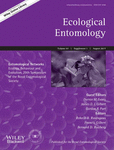
40. Klein S, Pasquaretta C, Barron AB, Devaud JM, Lihoreau M (2017). Inter-individual variability in the foraging behaviour of traplining bumblebees. Scientific Reports. 7:4561 PDF
39. Lihoreau M, Charleston MA, Senior AM, Clissold FJ, Raubenheimer D, Simpson SJ, Buhl J (2017). Collective foraging in spatially complex nutritional environments. Philosophical Transactions B. 372:20160238 PDF
38. Klein S, Cabirol A, Devaud JM, Barron AB, Lihoreau M (2017). Why bees are so vulnerable to environmental stressors. Trends in Ecology and Evolution. 32:268-278 PDF [TREE comment – Leonard and Hochuli 2017; PLoS Ecology community blog]

37. Bouchebti S, Durier V, Pasquaretta C, Rivault C, Lihoreau M (2016). Subsocial cockroaches Nauphoeta cinerea mate indiscriminately with kin despite high costs of inbreeding. PloS One. 11:e016548. PDF
36. Lihoreau M, Pasquaretta C, Heeb P. (2016). Commentary: Do bees play the producer-scrounger game? Frontiers in Psychology. 7:1355. PDF
35. Lihoreau M, Ings TC, Chittka L, Reynolds AM (2016). Signatures of a globally optimal searching strategy in the three-dimensional flights of bumblebees. Scientific Reports. 6:30401. PDF
34. Buatois A, Lihoreau M (2016). Evidence of trapline foraging in honeybees. Journal of Experimental Biology. 219:2426-2429. PDF
33. Lihoreau M, Poissonnier LA, Isabel G, Dussutour A (2016). Drosophila females trade off good nutrition with high quality oviposition sites when choosing foods. Journal of Experimental Biology. 219:2514-2524. PDF
32. Lihoreau M, Rivault C, van Zweden JS (2016). Kin discrimination increases with odour distance in the German cockroach. Behavioral Ecology. doi:10.1093/beheco/arw099 PDF
31. Senior AM, Lihoreau M, Charleston MA, Buhl J, Raubenheimer D, Simpson SJ (2016). Adaptive collective foraging in groups with conflicting nutritional needs. Royal Society Open Science. 3:150638. PDF
30. Lihoreau M, Chittka L, Raine NE (2016). Monitoring visitation networks and interactions between pairs of bumble bees in a large outdoor flight cage. PLoS One. 11:e0150844. [The Times, Daily Mail, CBC, Wired] PDF
29. Senior AM, Lihoreau M, Buhl J, Raubenheimer D, Simpson SJ (2016). Social network analyses and nutritional behavior: An integrated modeling approach. Frontiers in Psychology. 7:18. PDF
28. Lihoreau M, Clarke IM, Buhl J, Sumpter DJT, Simpson SJ (2016). Collective selection of food patches in Drosophila. Journal of Experimental Biology. 219:668-675 (Top 3 most-cited 2016 research paper) PDF
27. Wong ACN, Holmes A, Ponton F, Lihoreau M, Wilson K, Raubenheimer D, Simpson SJ (2015). Behavioural microbiomics: a multi-dimensional approach to microbial influence on behaviour. Frontiers in Microbiology. 6:1359. PDF
26. Senior AM, Nakagawa S, Lihoreau M, Simpson SJ, Raubenheimer D (2015). An overlooked consequence of dietary mixing: a varied diet reduces inter-individual variance in fitness. American Naturalist. 186:649-659. PDF
25. Senior AM, Charleston MA, Lihoreau M, Buhl J, Raubenheimer D, Simpson SJ (2015). Evolving nutritional strategies in the presence of competition: a geometric agent-based model. PLoS Computational Biology. 11:e1004111. PDF
24. Lihoreau M, Buhl J, Charleston MA, Sword GAS, Raubenheimer D, Simpson SJ (2015). Nutritional ecology beyond the individual: a conceptual framework for integrating nutrition and social interactions. Ecology Letters. 18:273-286. PDF
23. Avargues-Weber A, Lihoreau M, Isabel G, Giurfa M (2015). Information transfer beyond the waggle dance: observational learning in bees and flies. Frontiers in Ecology and Evolution. 3: Article 24. PDF
22. Simpson SJ, Clissold FJ, Lihoreau M, Ponton F, Wilder SM, Raubenheimer D (2015). Recent advances in the integrative nutrition of arthropods. Annual Review of Entomology. 60:293-311. PDF
21. Lihoreau M, Buhl J, Charleston MA, Sword GAS, Raubenheimer D, Simpson SJ (2014). Modelling nutrition across organizational levels: from individuals to superorganisms. Journal of Insect Physiology. 69:2-11. PDF
20. Lihoreau M, Raine NE (2013). Bee positive: the importance of electroreception in pollinator cognitive ecology. Frontiers in Psychology. 4:165. [La Recherche] PDF
19. Reynolds AM, Lihoreau M, Chittka L (2013). A simple iterative model accurately captures complex trapline formation by bumblebees across spatial scales and flower arrangement. PLoS Computational Biology. 9:e1002938. PDF
18. Lihoreau M, Raine NE, Reynolds AM, Stelzer RJ, Lim KS, Smith AD, Osborne JL, Chittka L (2013). Unravelling the mechanisms of trapline foraging in bees. Communicative & Integrative Biology 6:e22701. PDF
17. Lihoreau M, Latty T, Chittka L (2012). An exploration of the social brain hypothesis in insects. Frontiers in Physiology 3:165. PDF
16. Lihoreau M, Raine NE, Reynolds AM, Stelzer RJ, Lim KS, Smith AD, Osborne JL, Chittka L (2012) Radar tracking and motion sensitive cameras on flowers reveal the development of pollinator multi-destination routes over large spatial scales. PLoS Biology 10:e1001392. [The Times, Le Monde, Science NOW, Die Welt] PDF
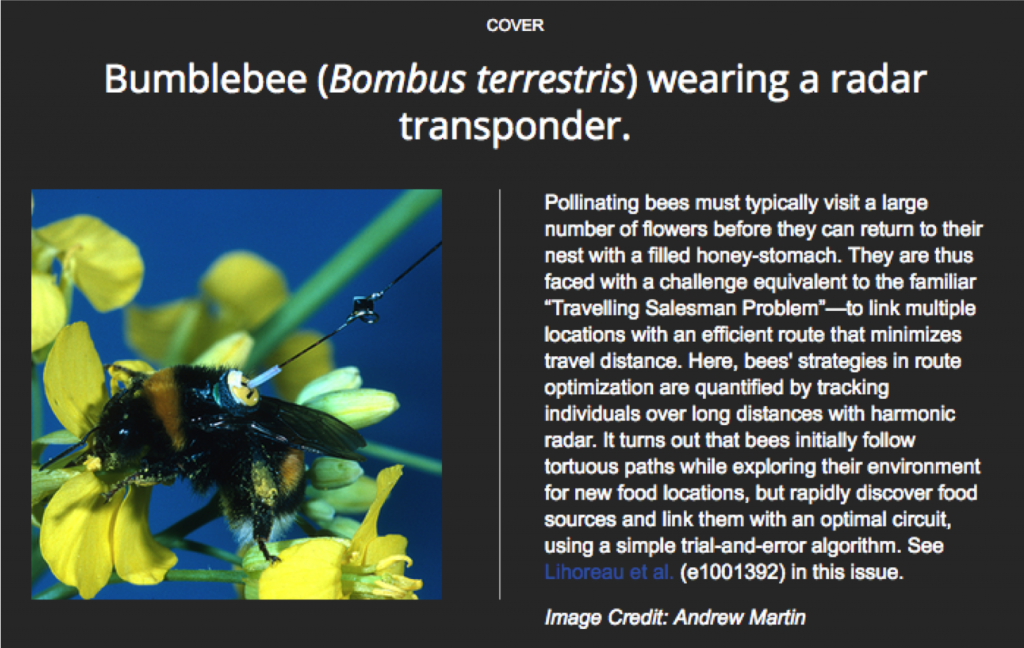
15. Tabadkani SM, Nozari J, Lihoreau M (2012) Inbreeding and the evolution of sociality in arthropods. Naturwissenschaften 99:779-788. PDF
14. Lihoreau M, Simpson SJ (2012) Food, « culture » and sociality in Drosophila. Frontiers in Psychology 3:165. PDF
13. Lihoreau M, Costa JT, Rivault C (2012) The social biology of domiciliary cockroaches: colony structure, kin recognition and collective decisions. Insectes Sociaux 59:445-452. [BBC Nature] PDF
12. Lihoreau M, Chittka L, Le Comber SC, Raine NE (2012) Bees do not use nearest-neighbour rules for optimization of multi-location routes. Biology Letters 8:13-16. [New Scientist, National Geographic, Science & Vie] PDF
10. Lihoreau M, Chittka L, Raine NE (2011) Trade-off between travel distance and prioritization of high reward sites in traplining bumblebees. Functional Ecology 25:1284-1292. [BBC 4, The Daily Mail, The Epoch Times] PDF
9. Lihoreau M, Chittka L, Raine NE (2010) Travel optimization by foraging bumblebees through re-adjustments of traplines after discovery of new feeding locations. American Naturalist 176:744-767. [BBC News, Fox News, MSNBC, The Guardian, The Independant, The Times] PDF
11. Lihoreau M, Rivault C (2011) Local enhancement promotes cockroach feeding aggregations. PLoS One 6:e22048. PDF
8. Lihoreau M (2010) Book review of Spatial cognition, spatial perception: mapping the self and space. Dolins FL ans Mitchel RW (eds). The Quarterly Review of Biology 85:506. PDF
7. Lihoreau M, Deneubourg J-L, Rivault C (2010) Collective foraging decision in a gregarious insect. Behavioral Ecology and Sociobiology 64:1577-1587. [ABC, BBC News, MSNBC, Discovery News] PDF
6. Lihoreau M, Rivault C (2010) German cockroach males maximize their inclusive fitness by avoiding mating with kin. Animal Behaviour 80:303-309. PDF
5. Lihoreau M, Brepson L, Rivault C (2009) The weight of the clan: even in insects, social isolation can induce a behavioural syndrome. Behavioural Processes 82:80-84. [Nature] PDF
4. Lihoreau M, Rivault C (2009) Kin recognition via cuticular hydrocarbons shapes cockroach social life. Behavioral Ecology 20:46-53. PDF
3. Lihoreau M, Zimmer C, Rivault C (2008) Mutual mate choice: when it pays both sexes to avoid inbreeding. PLoS One 3:e3365. [Faculty of 1000] PDF
2. Lihoreau M, Rivault C (2008) Tactile stimuli trigger group effects in cockroach aggregations. Animal Behaviour 75:1965-1972. PDF
1. Lihoreau M, Zimmer C, Rivault C (2007) Kin recognition and incest avoidance in a group living insect. Behavioral Ecology 18:880-887. PDF
BOOKS AND BOOK CHAPTERS
17. Lihoreau M (2024) What do bees think about? John Hopkins University Press. https://www.press.jhu.edu/books/title/53659/what-do-bees-think-about
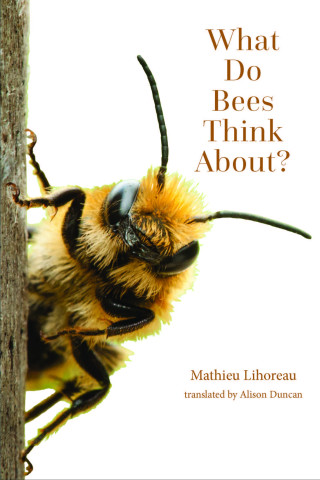
16. Tait C, Lihoreau M (2024) The energetics of foraging. In: « The foraging behavior of the honey bee (Apis mellifera) » (Purdy J, Ed). Elsevier. PDF
15. Doussot C, Purdy J, Lihoreau M (2024) Navigation: Cognition, learning and memory. In: « The foraging behavior of the honey bee (Apis mellifera) » (Purdy J, Ed). Elsevier. PDF
14. Lihoreau M (2022) A quoi pensent les abeilles. humenSciences. 9782379313622 https://www.humensciences.com/livre/A-quoi-pensent-les-abeilles-%3F/106
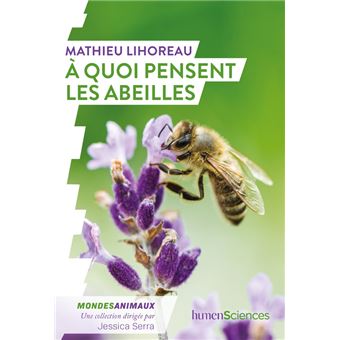
13. Lihoreau M, Gomez-Moracho T (2022) Where, what and with whom to eat: Towards an integrative study of foraging behaviour. In: « The Routledge International handbook of Comparative Psychology » (Freeberg TM, Ridley AR, d’Ettore P, Eds). Elsevier. 394p https://doi.org/10.4324/9781003091868
12. Lihoreau M, Gómez-Moracho T (2022) L’intelligence collective chez les abeilles. In « Psychologie des animaux » (Marmion JF, ed). Editions Sciences Humaines. https://www.scienceshumaines.com/
11. Giurfa M, Lihoreau M, Avarguès-Weber A, leconte Y (2020) Les abeilles, ces insectes formidables. Dans « Abeilles: une histoire intime avec l’humanité ». CNRS Editions. https://www.cnrs.fr/fr/abeilles-une-histoire-intime-avec-lhumanite
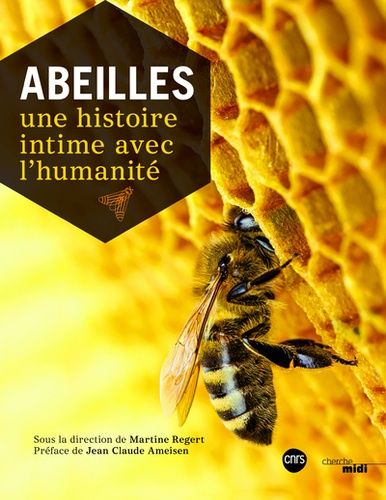
10. Even N, Bertrand O, Lihoreau M (2020) Navigation by honey bees. In « Encyclopedia of Animal Cognition and Behavior » (Vonk J, Shackelford TK eds). Springer. PDF link.springer.com/referencework/10.1007/978-3-319-47829-6
9. Schultheiss P, Wystrach A, Lihoreau M, Schwarz S (2020) Insect navigation. In « Encyclopedia of Animal Cognition and Behavior » (Vonk J, Shackelford TK eds). Springer. link.springer.com/referencework/10.1007/978-3-319-47829-6
8. Kraus S, Monchanin C, Gomez-Moracho T, Lihoreau M (2020) Insect Diet. In « Encyclopedia of Animal Cognition and Behavior » (Vonk J, Shackelford TK eds). Springer. PDF link.springer.com/referencework/10.1007/978-3-319-47829-6
7. Fouche Q, Charabidze D, Lihoreau M (2020) Aggregation. In « Encyclopedia of Animal Cognition and Behavior » (Vonk J, Shackelford TK eds). Springer. link.springer.com/referencework/10.1007/978-3-319-47829-6
6. Lihoreau M, Gómez-Moracho T, Pasquaretta C (2020) Traveling Salesman. In « Encyclopedia of Animal Cognition and Behavior » (Vonk J, Shackelford TK eds). Springer. PDF link.springer.com/referencework/10.1007/978-3-319-47829-6
5. Laurent-Salazar MO, Bouchebti S, Lihoreau M (2020) Gregarious cockroaches. In: Starr C. (eds) Encyclopedia of Social Insects. Springer. Springer. PDF link.springer.com/referencework/10.1007/978-3-319-90306-4
4. Kraus S, Gómez-Moracho T, Lihoreau M (2020) Nutrition in social insects. In: Starr C. (eds) Encyclopedia of Social Insects. Springer. PDF link.springer.com/referencework/10.1007/978-3-319-90306-4
3. Lihoreau M (2018) Nutritional interactions through the living: from individuals to societies and beyond. In « Life Sciences, Information Sciences » (Gaudin T, Lacroix D, Maurel MC, Pomerol JC eds). John Wiley & Sons, Inc. pp. 295-304. doi/abs/10.1002/9781119452713.ch27
2. Lihoreau M (2017) Comparative analysis of route learning in honey bees and bumblebees. Annales de la Fondation Fyssen N°31.
1. Lihoreau M (2017) Interactions nutritionnelles à travers le vivant: de l’individu à la société et au-delà. In « Sciences de la vie, Sciences de l’Information – Colloques de Cerisy » (Gaudin T, Lacroix D, Maurel MC, Pomerol JC eds). ISTE Editions. https://cerisy-colloques.fr/sciencesvie-pub2017/
OTHER PUBLICATIONS
12. Dore A, Henry D, Aubert H, Lihoreau M (2022). How do bees move across the landscapes? The Project Repository Journal. 12:76-79 PDF
11. Groupement de recherche Pollinéco (2022). Le nouveau plan « pollinisateurs » oublie l’essentiel: les pesticides. Le Monde. 07/01/2022. PDF
10. Monchanin C, Lihoreau M (2021). A toxic error. New Scientist. 251:25. PDF
9. Lihoreau M (2020) Cognitive underpinnings of social behaviour in insects. Habilitation à Diriger des Recherches de l’Université Paul Sabatier – Toulouse III.
8. Colin T, Monchanin C, Lihoreau M (2020) Insecticides: arrêtons de risquer l’overdose. Exploreur.
7. Le Moël F, Schwarz S, Lihoreau M, Wystrach A(2020) A killjoy representation of object representation by bumblebees. Science (eLetters).
6. Cabirol A, Klein S, Devaud JM, Lihoreau M (2018) Les abeilles sont-elles aussi victimes de leur intelligence? Liberation. PDF
5. Cabirol A, Klein S, Devaud JM, Lihoreau M (2018) Les abeilles sont-elles aussi victimes de leur intelligence? CNRS Le Journal.
4. Lihoreau M, Gómez-Moracho T (2018) L’intelligence collective chez les abeilles Cercle Psy. Hors série N°7:46-49. PDF
3. Klein S, Lihoreau M (2017) Vingt ans après le début de l’effondrement des colonies, comment se portent les abeilles? The Conversation.
2. Lihoreau M (2009) Organisation et fonctionnement des groupes sociaux chez une blatte grégaire : un autre modèle de société d’insectes. Thèse de l’Université de Rennes 1. PDF
1. Lihoreau M (2008) Les blattes : un autre modèle de sociétés. Science Ouest 244:8. PDF
For additional information see our institutional webpage.
